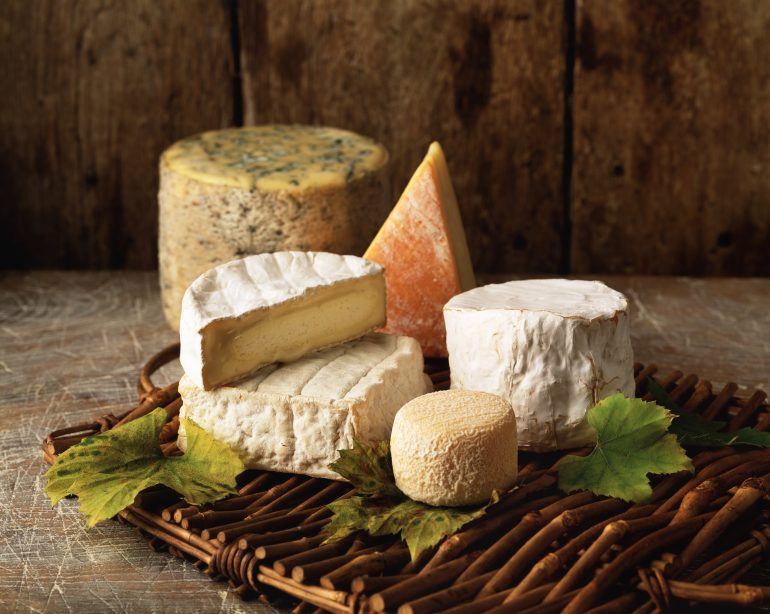On New Year’s Day 1836, US President Andrew Jackson was gifted a two tonne block of cheese. It was symbolic of one farmer’s prosperity and was displayed in the White House entrance for over a year. Legend has it, Jackson invited anyone who was hungry to come and break off a chunk. Other world leaders have also been presented with giant cheese offerings, including Thomas Jefferson and Queen Victoria. All of which is to say that cheese carries some major cultural clout.
Today, there are over 2000 varieties of cheese, boasting all kinds of weird and wonderful flavours, from pungent blue to salty halloumi. What’s more, cheese makes up a fifth of all dairy production worldwide. So how do they do it? Just how is cheese manufactured? For example, how is cheddar cheese made? And how do they make cheese in factories? We’ve got all the fats.
A Brief History of Cheese

A variety of cheeses (Photo: Diana Miller via Getty Images)
Nobody really knows when or how humans first worked out how cheese is made. Some believe it originates as far back as eight thousand years ago.
Whatever the case, the ancient Egyptians and Greeks certainly alluded to cheesemaking in their writings and art. And, by Roman times, cheese was an established and sought after product. During the height of the Empire, cheese was a popular food item among the more wealthy citizens of Rome. While there are no exact records of what types of cheese were consumed during this time, it’s believed that a number of different varieties were imported from all over the world.
In more modern times, cheese production began to expand throughout Europe, where cooler climates produced creamier milder cheeses, such as the French brie. However, it wasn’t until 1815 that the first cheese factory was built in Switzerland. In the 1860s, the industry received a boost when scientists developed a method for making rennet on a large scale. By the time of the Second World War, factories overtook farms in production. Cheese had become big business. With that in mind we’ll examine the question that is most relevant to cheese production today, how do they make cheese in factories?
How is Cheese Manufactured?

Cheese maker pouring milk into a stainless steel heating element (Photo: vm via Getty Images)
By definition, cheese contains milk solids or ‘curd’ that has been: (1) separated from the milk’s liquids or ‘whey’; and (2) coagulated, compressed, and usually ripened.
Beyond this, there are many variations in how cheese is made. Thus, while there is no single answer to the question ‘how do you make cheese’, there is a common process for most varieties.
What follows is a series of the most common steps in cheesemaking. Just bear in mind that almost every step is either optional or adaptable. Later, we’ll examine how this process applies to one specific example in ‘how is cheddar cheese made’.
How Do They Make Cheese in Factories?
Whether it’s from cows, goats, water buffalo or sheep, good cheese begins with good milk. Thus the first step is to inspect the milk received from farms and then filter it.
Standardisation
In terms of ‘how do they make cheese in factories’ it’s vital to produce a consistent end product. Thus, the process of how cheese is made usually involves standardising the milk. In other words, making it the same as the milk always used to make the cheese in question. That might mean adjusting the levels of fat, protein or cream in the milk.
Pasteurisation
Pasteurisation is the process of removing harmful bacteria. Some cheese is made from pasteurised milk, some from unpasteurised or ‘raw’ milk. If it is to be pasteurised, this will happen at this stage and done by heating the milk to around 72 degrees centigrade for about 15 seconds. This is achieved by running the milk through hot stainless steel plates. It’s then rapidly cooled to approximately 32 degrees.
Adding Bacteria
While the milk is maintained at around 32 degrees centigrade, the starter cultures are introduced. These ‘good bacteria’ ferment the natural sugar in milk, known as lactose, turning it into lactic acid. Again, there are many types of starter cultures that can be used depending on the cheese being produced. And it’s at this point that the cheese starts to develop its eventual flavour.
Separating Curd and Whey
This step in the process depends on the introduction of an enzyme called rennet. Rennet is responsible for coagulating the milk, which helps to form the curds that are used to make cheese – without rennet, cheese would not be able to form. In this step of how cheese is manufactured, rennet works to separate the solids or ‘curd’ in milk from the liquids or ‘whey’.
This is added along with other ingredients, causing the milk to take on a yoghurt-like consistency. Then the cheese is cut using wires or special knives. Cutting the cheese when it reaches this state allows the whey to separate from the curd. The more the milk is cut at this stage, the more whey is released, resulting in harder cheese. To release more whey, the curds are heated and stirred.
Shaping
It’s time for the cheese to start looking the part. This can either be done by salting or brining the curd. Salted curd is pressed into a form, while the brining method takes place once the curd is placed in a hoop.
Ageing
In terms of how cheese is made, the ageing process not only alters its texture, but intensifies its flavour. Ageing works in a number of ways. Firstly, as cheese matures, it loses moisture. The ageing also allows time for enzymes and bacteria to further develop.
Generally, ageing can take anything from a few weeks to several months. The longest aged edible cheese is called Bitto Storico. Matured for a staggering 18 years, this is one cheese that’s old enough to vote.
The process of ageing differs greatly depending on the intended end product. Temperature and humidity all play a part, as does whether it is wrapped and, if so, in what. Most cheeses are matured in high humidity at around 10 degrees centigrade. They can be wrapped in cloth, covered in wax or left uncovered. During the ageing process, some cheeses will be rubbed with brine or other components.
Many of the unusual characteristics of cheese develop during ageing. For example:
How Do You Make Cheese With Mould?
The ageing also allows mould to develop. For example, blue cheese is infused with the mould penicillium, which accounts for its coloured veins. Swiss cheese is made with bacteria that produce carbon dioxide (CO2) when they digest lactose. The bubbles of CO2 are what create the holes in the cheese.
How Do You Make Cheese With Holes?
The holes in Swiss cheese are the result of a bacteria which produces carbon dioxide. As it ages, this causes bubbles to develop in the cheese. Cheese that does not undergo ageing or very little ageing is called ‘fresh’ cheese and is generally much milder and saltier. Examples include mozzarella and cottage cheese.
Packaging
Once ready, there are many ways of packaging cheese. It might be sold whole, cut into wedges, sliced or grated.
How is Cheddar Cheese Made?

Worker adding rennet to milk for cheese-making (Photo: Monty Rakusen via Getty Images)
Cheddar cheese is a medium to hard off-white cheese made of cow’s milk. Named after the Somerset village where it originated, it dates back to at least the 12th century.
The answer to ‘how is cheddar cheese made’ begins with standardisation and pasteurisation of the milk followed by the bacteria and rennet stages as set out above. The starter culture used for cheddar is mesophilic lactic acid bacteria.
The curds are cut and heated gently, with the whey drained away. The next step differs from the standard process and is in fact called cheddaring. This is where the curds form slabs which are cut and stacked. The curds are milled, breaking them into small pieces which are then salted before being pressed into blocks.
Cheddar is often aged in wooden boxes. Depending on how long cheddar is aged, it’s categorised as mild, mature or extra mature. Generally;
- Mild cheddar is matured for 2 to 3 months
- Mature cheddar can be aged for around a year
- Extra mature or ‘vintage’ cheddar might be aged for 15 months and even up to two years.
Explaining how Cheese is Manufactured

Friends eating a cheese fondue at dinner (Photo: SolStock via Getty Images)
We’ve waxed lyrical on all matters fromage, from ‘how do you make cheese?’ to ‘how is cheddar cheese made’. And one thing is clear: the answer to ‘how do they make cheese in factories‘ is nothing to sniff at. Indeed, how cheese is made is clearly a complex mix of science and culinary skill.











